Assessment 1: Financial Accounting for Linda's Sole Trader Business
VerifiedAdded on 2022/12/29
|16
|2596
|57
Homework Assignment
AI Summary
This assignment analyzes the financial performance of a sole trader, Linda, for the month of October 2020. The assignment begins with double-entry bookkeeping entries for various transactions, including cash, sales, purchases, and expenses. These entries are then used to balance the accounts and prepare a trial balance. Based on the trial balance, an income statement and a statement of financial position are created to assess Linda's financial performance. The assignment also includes a brief letter explaining the treatment of drawings. Finally, the assignment delves into ratio analysis, calculating and interpreting key ratios such as the net profit ratio, gross profit ratio, current ratio, quick ratio, accounts receivable collection period, and accounts payable payment period. A comparison is made with industry averages to evaluate Linda's business's financial health and identify areas for improvement, providing insights into working capital management and overall profitability.

Assessment
1
1
Paraphrase This Document
Need a fresh take? Get an instant paraphrase of this document with our AI Paraphraser
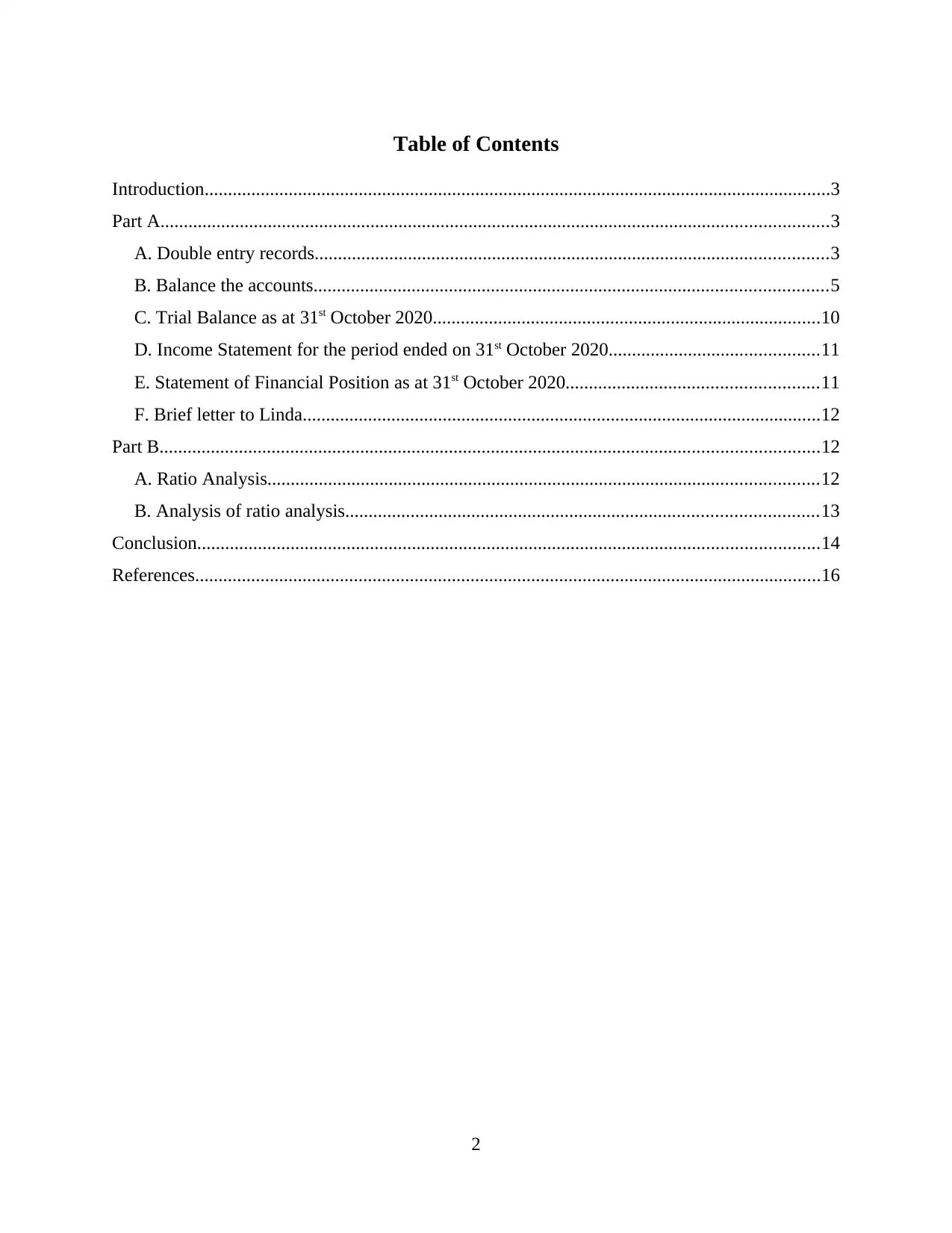
Table of Contents
Introduction......................................................................................................................................3
Part A...............................................................................................................................................3
A. Double entry records..............................................................................................................3
B. Balance the accounts..............................................................................................................5
C. Trial Balance as at 31st October 2020...................................................................................10
D. Income Statement for the period ended on 31st October 2020.............................................11
E. Statement of Financial Position as at 31st October 2020......................................................11
F. Brief letter to Linda...............................................................................................................12
Part B.............................................................................................................................................12
A. Ratio Analysis......................................................................................................................12
B. Analysis of ratio analysis.....................................................................................................13
Conclusion.....................................................................................................................................14
References......................................................................................................................................16
2
Introduction......................................................................................................................................3
Part A...............................................................................................................................................3
A. Double entry records..............................................................................................................3
B. Balance the accounts..............................................................................................................5
C. Trial Balance as at 31st October 2020...................................................................................10
D. Income Statement for the period ended on 31st October 2020.............................................11
E. Statement of Financial Position as at 31st October 2020......................................................11
F. Brief letter to Linda...............................................................................................................12
Part B.............................................................................................................................................12
A. Ratio Analysis......................................................................................................................12
B. Analysis of ratio analysis.....................................................................................................13
Conclusion.....................................................................................................................................14
References......................................................................................................................................16
2

Introduction
Books of accounts in a business are maintained to record all the materially significant
events that takes place in the course of business as transactions. Only financial parts of events are
recorded in the books of accounts (Wild, Shaw and Chiappetta, 2015). They are recorded in
accordance with the guided principles and conventions of accounting in books of accounts like
journal, ledger and trial balance. Balances obtained out of trial balance is used to prepare final
accounts which includes income statement, statement of financial position and cash flow
statement. Final accounts are then used for further analysis by both internal and external
stakeholders of business through various techniques such as ratio analysis. This report is aimed
at exploring this whole process of recording business transactions in primary books of accounts
to ratio analysis of a sole trader Linda.
Part A
A. Double entry records
Journal
(For the month October 2020)
Date Particulars L.F. Dr. (in GBP) Cr. (in GBP)
01/10/20 Cash-at-bank A/c...........................................Dr. 8000
Cash-in-hand A/c..........................................Dr. 5200
Van A/c........................................................Dr. 3000
To Capital A/c..... 16200
(Business started with cash-in-hand, van and
cash-at-bank)
02/10/20 Laptop A/c....................................................Dr. 1000
To Cash-at-bank A/c...... 1000
(New laptop bought and cheque paid)
3
Books of accounts in a business are maintained to record all the materially significant
events that takes place in the course of business as transactions. Only financial parts of events are
recorded in the books of accounts (Wild, Shaw and Chiappetta, 2015). They are recorded in
accordance with the guided principles and conventions of accounting in books of accounts like
journal, ledger and trial balance. Balances obtained out of trial balance is used to prepare final
accounts which includes income statement, statement of financial position and cash flow
statement. Final accounts are then used for further analysis by both internal and external
stakeholders of business through various techniques such as ratio analysis. This report is aimed
at exploring this whole process of recording business transactions in primary books of accounts
to ratio analysis of a sole trader Linda.
Part A
A. Double entry records
Journal
(For the month October 2020)
Date Particulars L.F. Dr. (in GBP) Cr. (in GBP)
01/10/20 Cash-at-bank A/c...........................................Dr. 8000
Cash-in-hand A/c..........................................Dr. 5200
Van A/c........................................................Dr. 3000
To Capital A/c..... 16200
(Business started with cash-in-hand, van and
cash-at-bank)
02/10/20 Laptop A/c....................................................Dr. 1000
To Cash-at-bank A/c...... 1000
(New laptop bought and cheque paid)
3
⊘ This is a preview!⊘
Do you want full access?
Subscribe today to unlock all pages.

Trusted by 1+ million students worldwide
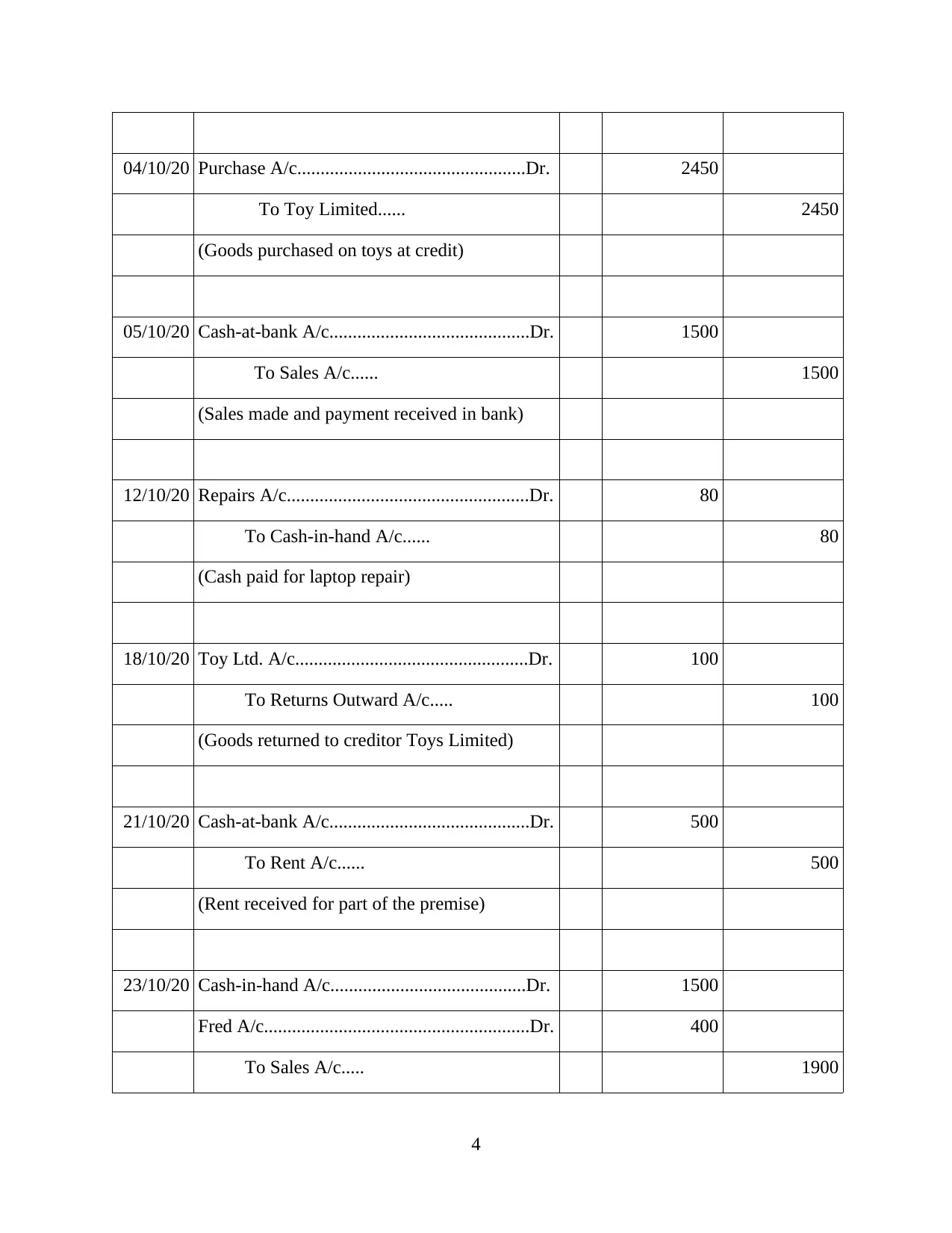
04/10/20 Purchase A/c.................................................Dr. 2450
To Toy Limited...... 2450
(Goods purchased on toys at credit)
05/10/20 Cash-at-bank A/c...........................................Dr. 1500
To Sales A/c...... 1500
(Sales made and payment received in bank)
12/10/20 Repairs A/c....................................................Dr. 80
To Cash-in-hand A/c...... 80
(Cash paid for laptop repair)
18/10/20 Toy Ltd. A/c..................................................Dr. 100
To Returns Outward A/c..... 100
(Goods returned to creditor Toys Limited)
21/10/20 Cash-at-bank A/c...........................................Dr. 500
To Rent A/c...... 500
(Rent received for part of the premise)
23/10/20 Cash-in-hand A/c..........................................Dr. 1500
Fred A/c.........................................................Dr. 400
To Sales A/c..... 1900
4
To Toy Limited...... 2450
(Goods purchased on toys at credit)
05/10/20 Cash-at-bank A/c...........................................Dr. 1500
To Sales A/c...... 1500
(Sales made and payment received in bank)
12/10/20 Repairs A/c....................................................Dr. 80
To Cash-in-hand A/c...... 80
(Cash paid for laptop repair)
18/10/20 Toy Ltd. A/c..................................................Dr. 100
To Returns Outward A/c..... 100
(Goods returned to creditor Toys Limited)
21/10/20 Cash-at-bank A/c...........................................Dr. 500
To Rent A/c...... 500
(Rent received for part of the premise)
23/10/20 Cash-in-hand A/c..........................................Dr. 1500
Fred A/c.........................................................Dr. 400
To Sales A/c..... 1900
4
Paraphrase This Document
Need a fresh take? Get an instant paraphrase of this document with our AI Paraphraser
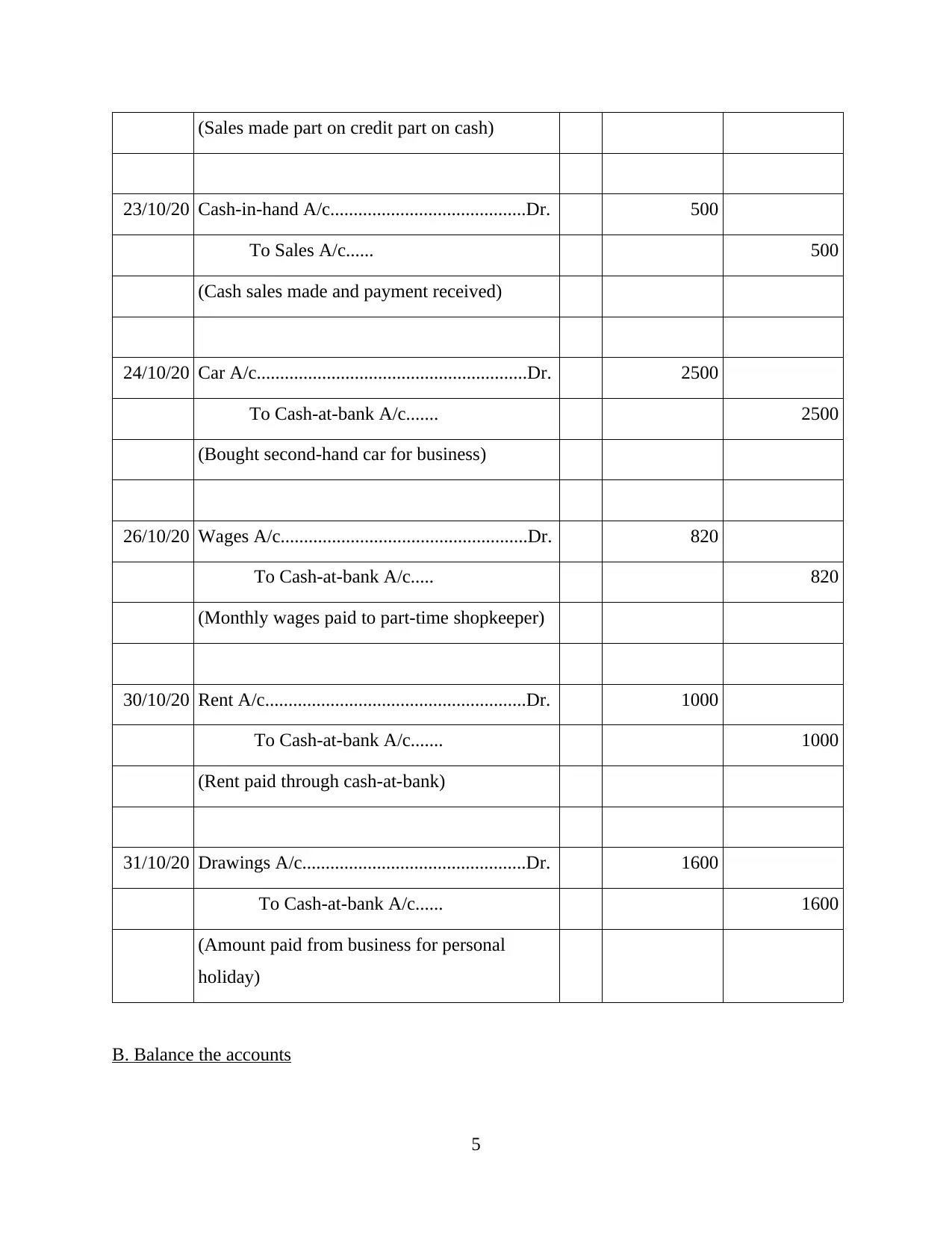
(Sales made part on credit part on cash)
23/10/20 Cash-in-hand A/c..........................................Dr. 500
To Sales A/c...... 500
(Cash sales made and payment received)
24/10/20 Car A/c..........................................................Dr. 2500
To Cash-at-bank A/c....... 2500
(Bought second-hand car for business)
26/10/20 Wages A/c.....................................................Dr. 820
To Cash-at-bank A/c..... 820
(Monthly wages paid to part-time shopkeeper)
30/10/20 Rent A/c........................................................Dr. 1000
To Cash-at-bank A/c....... 1000
(Rent paid through cash-at-bank)
31/10/20 Drawings A/c................................................Dr. 1600
To Cash-at-bank A/c...... 1600
(Amount paid from business for personal
holiday)
B. Balance the accounts
5
23/10/20 Cash-in-hand A/c..........................................Dr. 500
To Sales A/c...... 500
(Cash sales made and payment received)
24/10/20 Car A/c..........................................................Dr. 2500
To Cash-at-bank A/c....... 2500
(Bought second-hand car for business)
26/10/20 Wages A/c.....................................................Dr. 820
To Cash-at-bank A/c..... 820
(Monthly wages paid to part-time shopkeeper)
30/10/20 Rent A/c........................................................Dr. 1000
To Cash-at-bank A/c....... 1000
(Rent paid through cash-at-bank)
31/10/20 Drawings A/c................................................Dr. 1600
To Cash-at-bank A/c...... 1600
(Amount paid from business for personal
holiday)
B. Balance the accounts
5
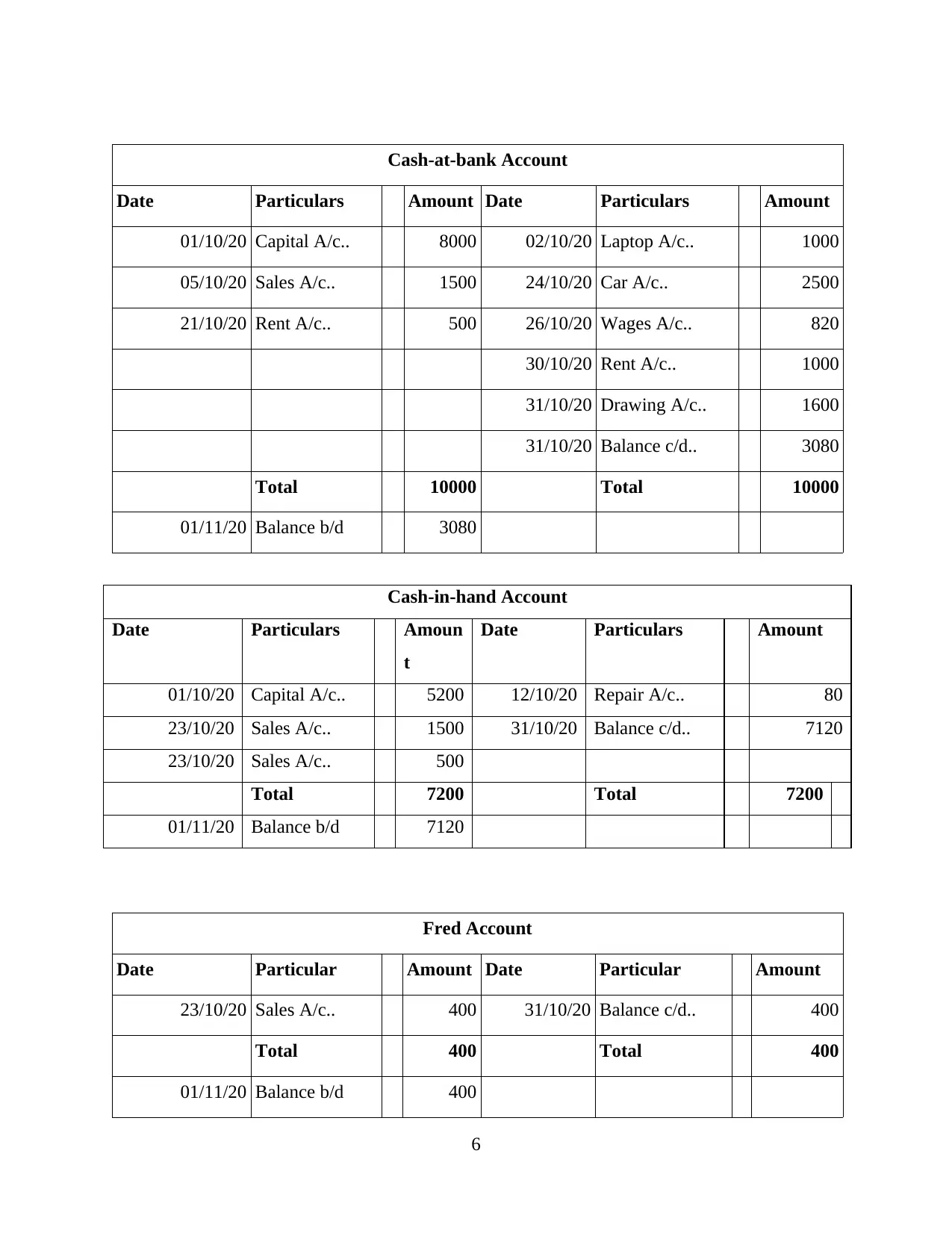
Cash-at-bank Account
Date Particulars Amount Date Particulars Amount
01/10/20 Capital A/c.. 8000 02/10/20 Laptop A/c.. 1000
05/10/20 Sales A/c.. 1500 24/10/20 Car A/c.. 2500
21/10/20 Rent A/c.. 500 26/10/20 Wages A/c.. 820
30/10/20 Rent A/c.. 1000
31/10/20 Drawing A/c.. 1600
31/10/20 Balance c/d.. 3080
Total 10000 Total 10000
01/11/20 Balance b/d 3080
Cash-in-hand Account
Date Particulars Amoun
t
Date Particulars Amount
01/10/20 Capital A/c.. 5200 12/10/20 Repair A/c.. 80
23/10/20 Sales A/c.. 1500 31/10/20 Balance c/d.. 7120
23/10/20 Sales A/c.. 500
Total 7200 Total 7200
01/11/20 Balance b/d 7120
Fred Account
Date Particular Amount Date Particular Amount
23/10/20 Sales A/c.. 400 31/10/20 Balance c/d.. 400
Total 400 Total 400
01/11/20 Balance b/d 400
6
Date Particulars Amount Date Particulars Amount
01/10/20 Capital A/c.. 8000 02/10/20 Laptop A/c.. 1000
05/10/20 Sales A/c.. 1500 24/10/20 Car A/c.. 2500
21/10/20 Rent A/c.. 500 26/10/20 Wages A/c.. 820
30/10/20 Rent A/c.. 1000
31/10/20 Drawing A/c.. 1600
31/10/20 Balance c/d.. 3080
Total 10000 Total 10000
01/11/20 Balance b/d 3080
Cash-in-hand Account
Date Particulars Amoun
t
Date Particulars Amount
01/10/20 Capital A/c.. 5200 12/10/20 Repair A/c.. 80
23/10/20 Sales A/c.. 1500 31/10/20 Balance c/d.. 7120
23/10/20 Sales A/c.. 500
Total 7200 Total 7200
01/11/20 Balance b/d 7120
Fred Account
Date Particular Amount Date Particular Amount
23/10/20 Sales A/c.. 400 31/10/20 Balance c/d.. 400
Total 400 Total 400
01/11/20 Balance b/d 400
6
⊘ This is a preview!⊘
Do you want full access?
Subscribe today to unlock all pages.

Trusted by 1+ million students worldwide
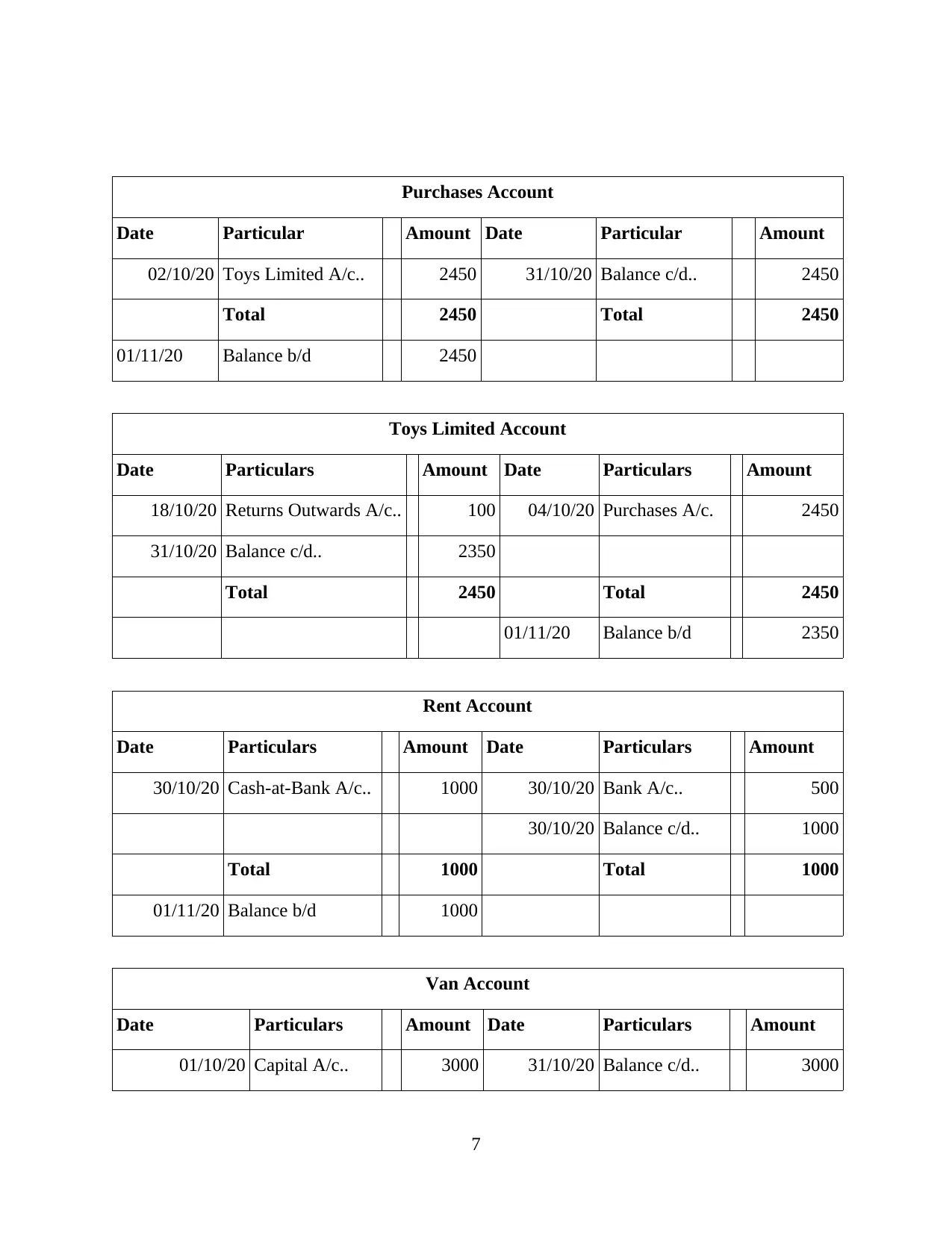
Purchases Account
Date Particular Amount Date Particular Amount
02/10/20 Toys Limited A/c.. 2450 31/10/20 Balance c/d.. 2450
Total 2450 Total 2450
01/11/20 Balance b/d 2450
Toys Limited Account
Date Particulars Amount Date Particulars Amount
18/10/20 Returns Outwards A/c.. 100 04/10/20 Purchases A/c. 2450
31/10/20 Balance c/d.. 2350
Total 2450 Total 2450
01/11/20 Balance b/d 2350
Rent Account
Date Particulars Amount Date Particulars Amount
30/10/20 Cash-at-Bank A/c.. 1000 30/10/20 Bank A/c.. 500
30/10/20 Balance c/d.. 1000
Total 1000 Total 1000
01/11/20 Balance b/d 1000
Van Account
Date Particulars Amount Date Particulars Amount
01/10/20 Capital A/c.. 3000 31/10/20 Balance c/d.. 3000
7
Date Particular Amount Date Particular Amount
02/10/20 Toys Limited A/c.. 2450 31/10/20 Balance c/d.. 2450
Total 2450 Total 2450
01/11/20 Balance b/d 2450
Toys Limited Account
Date Particulars Amount Date Particulars Amount
18/10/20 Returns Outwards A/c.. 100 04/10/20 Purchases A/c. 2450
31/10/20 Balance c/d.. 2350
Total 2450 Total 2450
01/11/20 Balance b/d 2350
Rent Account
Date Particulars Amount Date Particulars Amount
30/10/20 Cash-at-Bank A/c.. 1000 30/10/20 Bank A/c.. 500
30/10/20 Balance c/d.. 1000
Total 1000 Total 1000
01/11/20 Balance b/d 1000
Van Account
Date Particulars Amount Date Particulars Amount
01/10/20 Capital A/c.. 3000 31/10/20 Balance c/d.. 3000
7
Paraphrase This Document
Need a fresh take? Get an instant paraphrase of this document with our AI Paraphraser
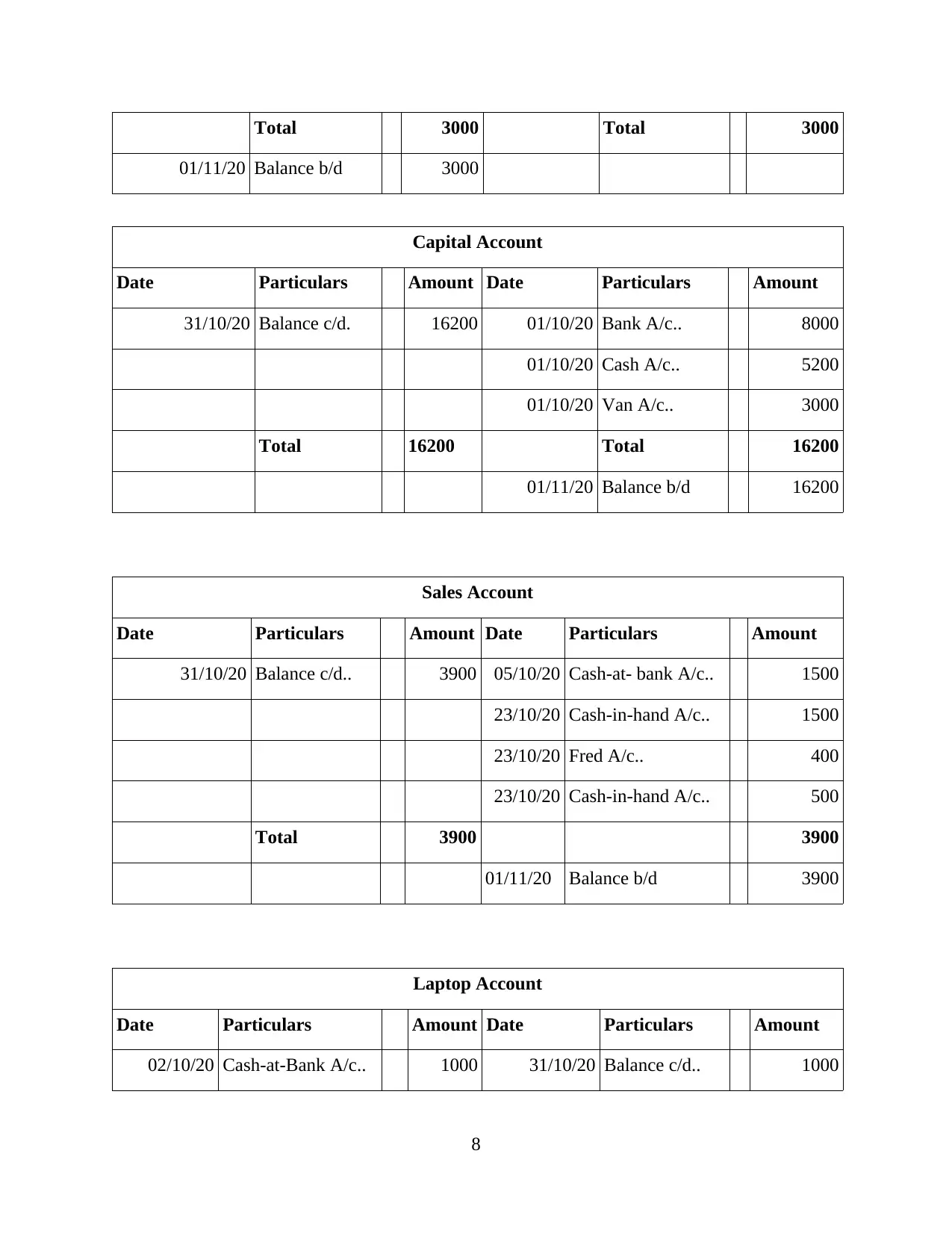
Total 3000 Total 3000
01/11/20 Balance b/d 3000
Capital Account
Date Particulars Amount Date Particulars Amount
31/10/20 Balance c/d. 16200 01/10/20 Bank A/c.. 8000
01/10/20 Cash A/c.. 5200
01/10/20 Van A/c.. 3000
Total 16200 Total 16200
01/11/20 Balance b/d 16200
Sales Account
Date Particulars Amount Date Particulars Amount
31/10/20 Balance c/d.. 3900 05/10/20 Cash-at- bank A/c.. 1500
23/10/20 Cash-in-hand A/c.. 1500
23/10/20 Fred A/c.. 400
23/10/20 Cash-in-hand A/c.. 500
Total 3900 3900
01/11/20 Balance b/d 3900
Laptop Account
Date Particulars Amount Date Particulars Amount
02/10/20 Cash-at-Bank A/c.. 1000 31/10/20 Balance c/d.. 1000
8
01/11/20 Balance b/d 3000
Capital Account
Date Particulars Amount Date Particulars Amount
31/10/20 Balance c/d. 16200 01/10/20 Bank A/c.. 8000
01/10/20 Cash A/c.. 5200
01/10/20 Van A/c.. 3000
Total 16200 Total 16200
01/11/20 Balance b/d 16200
Sales Account
Date Particulars Amount Date Particulars Amount
31/10/20 Balance c/d.. 3900 05/10/20 Cash-at- bank A/c.. 1500
23/10/20 Cash-in-hand A/c.. 1500
23/10/20 Fred A/c.. 400
23/10/20 Cash-in-hand A/c.. 500
Total 3900 3900
01/11/20 Balance b/d 3900
Laptop Account
Date Particulars Amount Date Particulars Amount
02/10/20 Cash-at-Bank A/c.. 1000 31/10/20 Balance c/d.. 1000
8
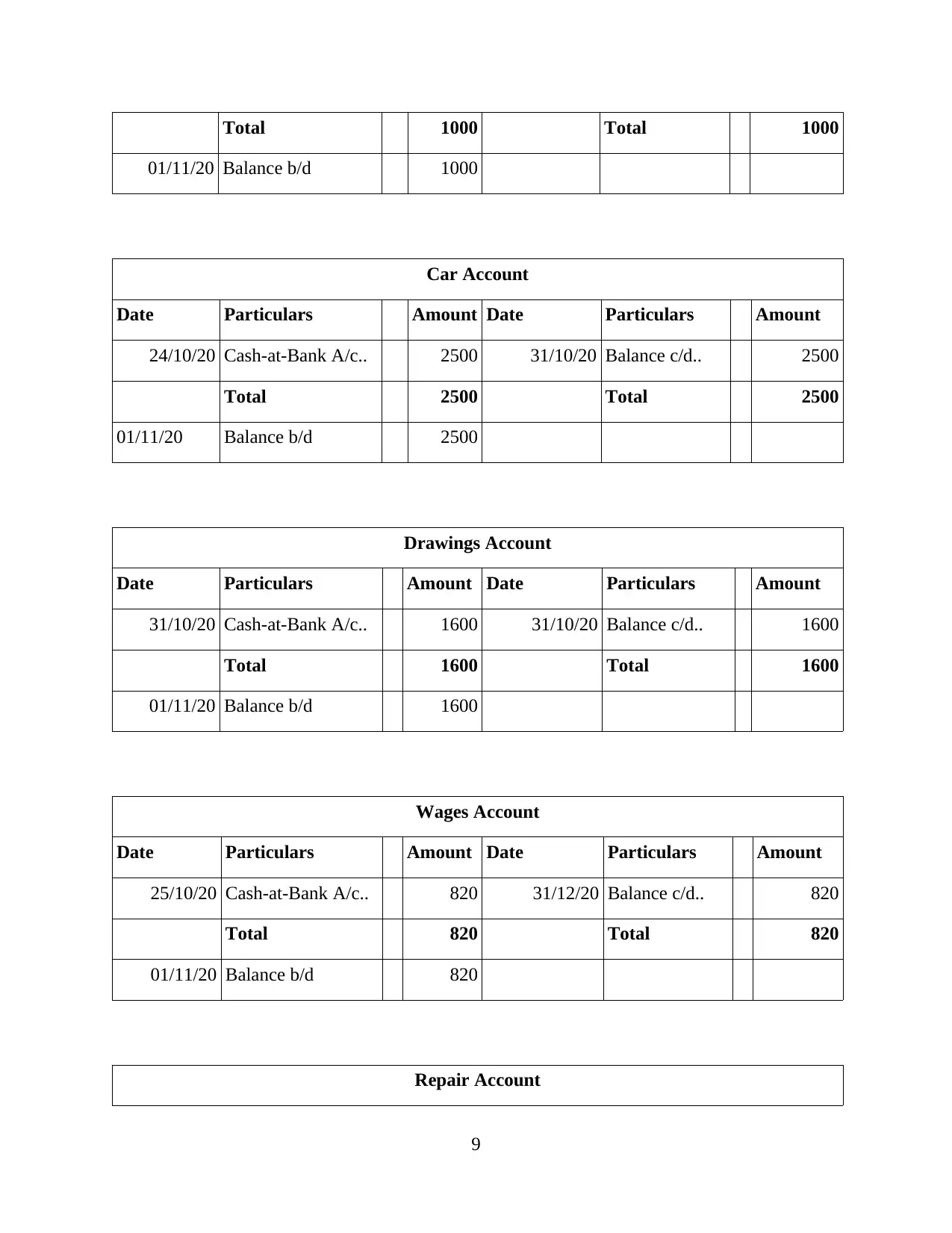
Total 1000 Total 1000
01/11/20 Balance b/d 1000
Car Account
Date Particulars Amount Date Particulars Amount
24/10/20 Cash-at-Bank A/c.. 2500 31/10/20 Balance c/d.. 2500
Total 2500 Total 2500
01/11/20 Balance b/d 2500
Drawings Account
Date Particulars Amount Date Particulars Amount
31/10/20 Cash-at-Bank A/c.. 1600 31/10/20 Balance c/d.. 1600
Total 1600 Total 1600
01/11/20 Balance b/d 1600
Wages Account
Date Particulars Amount Date Particulars Amount
25/10/20 Cash-at-Bank A/c.. 820 31/12/20 Balance c/d.. 820
Total 820 Total 820
01/11/20 Balance b/d 820
Repair Account
9
01/11/20 Balance b/d 1000
Car Account
Date Particulars Amount Date Particulars Amount
24/10/20 Cash-at-Bank A/c.. 2500 31/10/20 Balance c/d.. 2500
Total 2500 Total 2500
01/11/20 Balance b/d 2500
Drawings Account
Date Particulars Amount Date Particulars Amount
31/10/20 Cash-at-Bank A/c.. 1600 31/10/20 Balance c/d.. 1600
Total 1600 Total 1600
01/11/20 Balance b/d 1600
Wages Account
Date Particulars Amount Date Particulars Amount
25/10/20 Cash-at-Bank A/c.. 820 31/12/20 Balance c/d.. 820
Total 820 Total 820
01/11/20 Balance b/d 820
Repair Account
9
⊘ This is a preview!⊘
Do you want full access?
Subscribe today to unlock all pages.

Trusted by 1+ million students worldwide
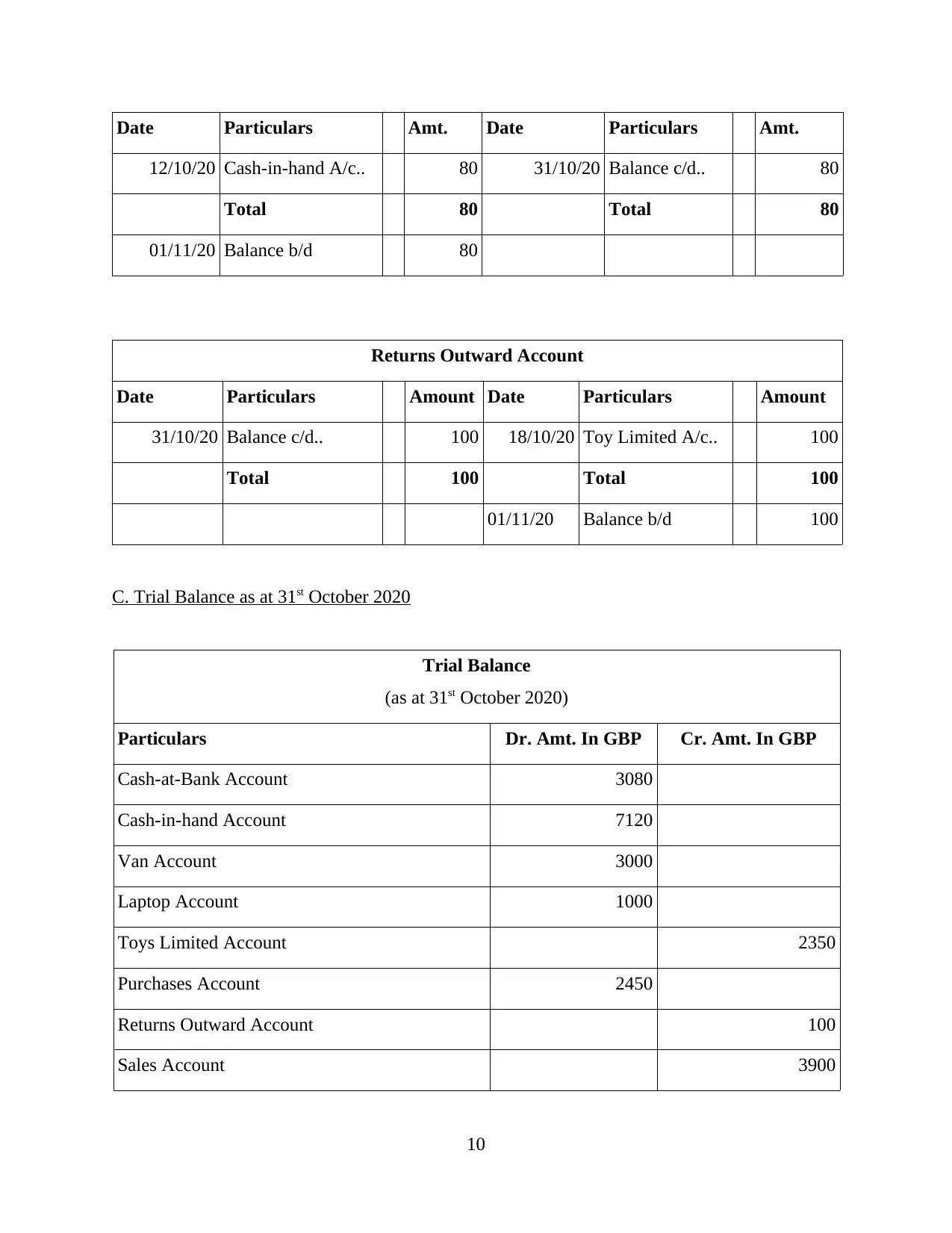
Date Particulars Amt. Date Particulars Amt.
12/10/20 Cash-in-hand A/c.. 80 31/10/20 Balance c/d.. 80
Total 80 Total 80
01/11/20 Balance b/d 80
Returns Outward Account
Date Particulars Amount Date Particulars Amount
31/10/20 Balance c/d.. 100 18/10/20 Toy Limited A/c.. 100
Total 100 Total 100
01/11/20 Balance b/d 100
C. Trial Balance as at 31st October 2020
Trial Balance
(as at 31st October 2020)
Particulars Dr. Amt. In GBP Cr. Amt. In GBP
Cash-at-Bank Account 3080
Cash-in-hand Account 7120
Van Account 3000
Laptop Account 1000
Toys Limited Account 2350
Purchases Account 2450
Returns Outward Account 100
Sales Account 3900
10
12/10/20 Cash-in-hand A/c.. 80 31/10/20 Balance c/d.. 80
Total 80 Total 80
01/11/20 Balance b/d 80
Returns Outward Account
Date Particulars Amount Date Particulars Amount
31/10/20 Balance c/d.. 100 18/10/20 Toy Limited A/c.. 100
Total 100 Total 100
01/11/20 Balance b/d 100
C. Trial Balance as at 31st October 2020
Trial Balance
(as at 31st October 2020)
Particulars Dr. Amt. In GBP Cr. Amt. In GBP
Cash-at-Bank Account 3080
Cash-in-hand Account 7120
Van Account 3000
Laptop Account 1000
Toys Limited Account 2350
Purchases Account 2450
Returns Outward Account 100
Sales Account 3900
10
Paraphrase This Document
Need a fresh take? Get an instant paraphrase of this document with our AI Paraphraser
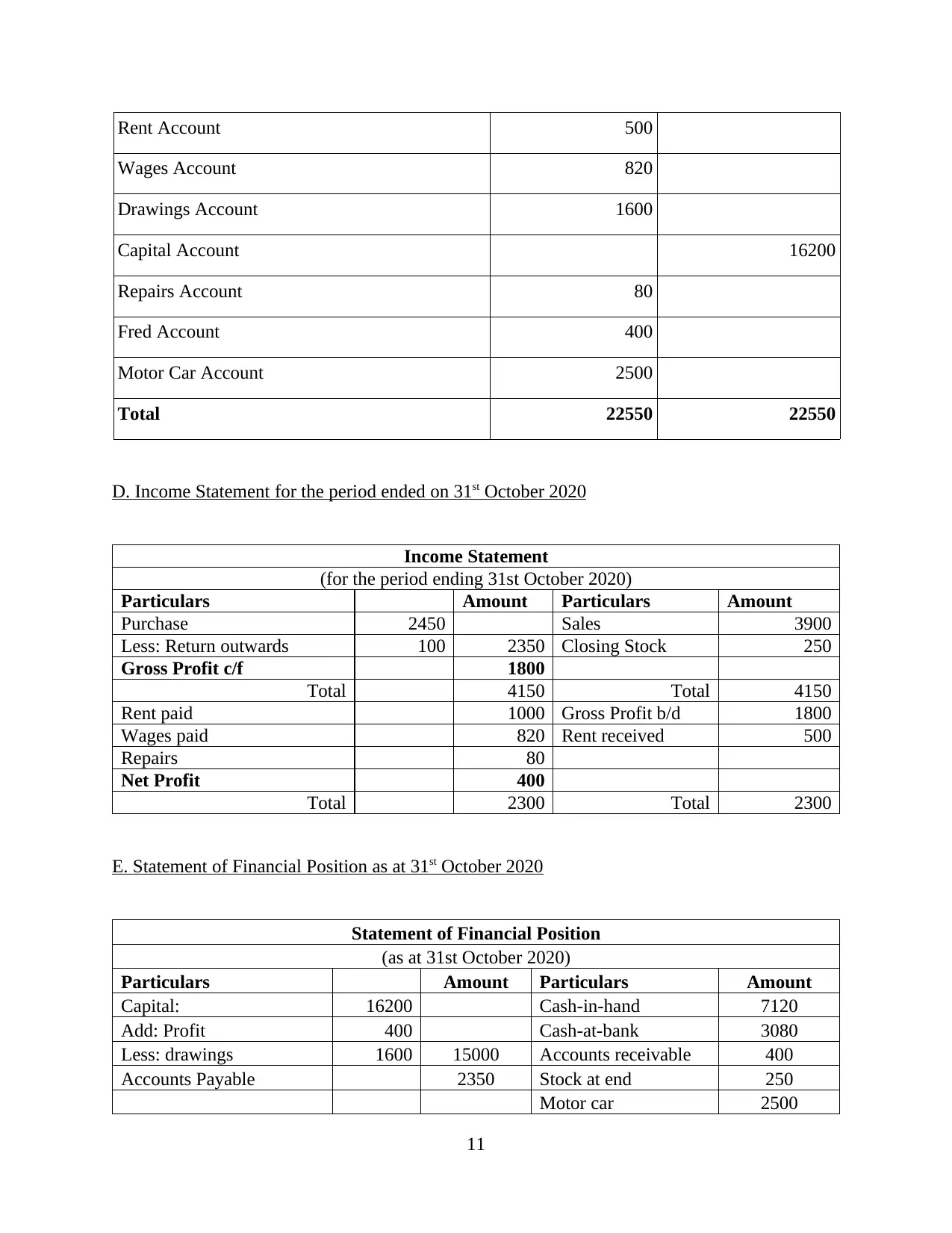
Rent Account 500
Wages Account 820
Drawings Account 1600
Capital Account 16200
Repairs Account 80
Fred Account 400
Motor Car Account 2500
Total 22550 22550
D. Income Statement for the period ended on 31st October 2020
Income Statement
(for the period ending 31st October 2020)
Particulars Amount Particulars Amount
Purchase 2450 Sales 3900
Less: Return outwards 100 2350 Closing Stock 250
Gross Profit c/f 1800
Total 4150 Total 4150
Rent paid 1000 Gross Profit b/d 1800
Wages paid 820 Rent received 500
Repairs 80
Net Profit 400
Total 2300 Total 2300
E. Statement of Financial Position as at 31st October 2020
Statement of Financial Position
(as at 31st October 2020)
Particulars Amount Particulars Amount
Capital: 16200 Cash-in-hand 7120
Add: Profit 400 Cash-at-bank 3080
Less: drawings 1600 15000 Accounts receivable 400
Accounts Payable 2350 Stock at end 250
Motor car 2500
11
Wages Account 820
Drawings Account 1600
Capital Account 16200
Repairs Account 80
Fred Account 400
Motor Car Account 2500
Total 22550 22550
D. Income Statement for the period ended on 31st October 2020
Income Statement
(for the period ending 31st October 2020)
Particulars Amount Particulars Amount
Purchase 2450 Sales 3900
Less: Return outwards 100 2350 Closing Stock 250
Gross Profit c/f 1800
Total 4150 Total 4150
Rent paid 1000 Gross Profit b/d 1800
Wages paid 820 Rent received 500
Repairs 80
Net Profit 400
Total 2300 Total 2300
E. Statement of Financial Position as at 31st October 2020
Statement of Financial Position
(as at 31st October 2020)
Particulars Amount Particulars Amount
Capital: 16200 Cash-in-hand 7120
Add: Profit 400 Cash-at-bank 3080
Less: drawings 1600 15000 Accounts receivable 400
Accounts Payable 2350 Stock at end 250
Motor car 2500
11
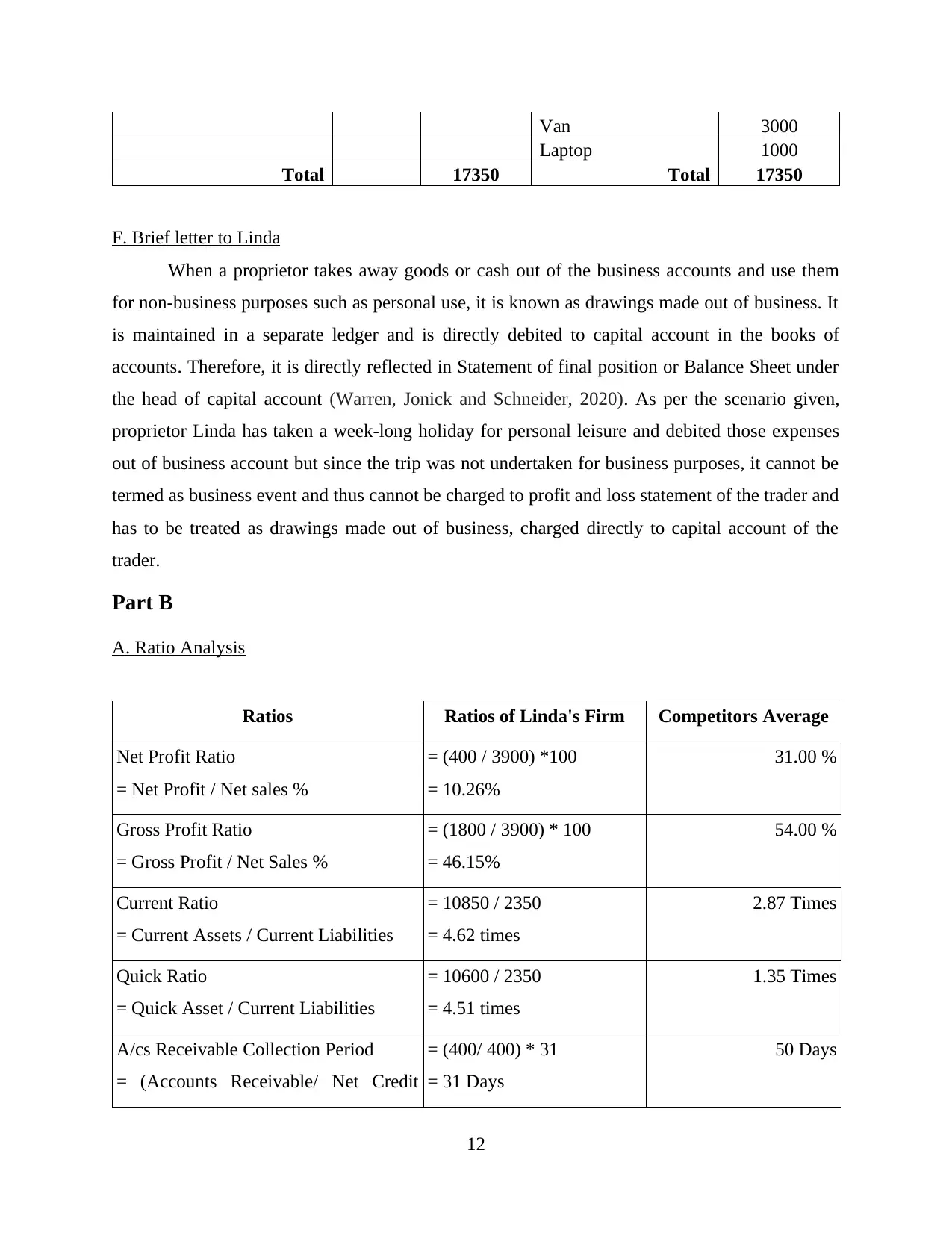
Van 3000
Laptop 1000
Total 17350 Total 17350
F. Brief letter to Linda
When a proprietor takes away goods or cash out of the business accounts and use them
for non-business purposes such as personal use, it is known as drawings made out of business. It
is maintained in a separate ledger and is directly debited to capital account in the books of
accounts. Therefore, it is directly reflected in Statement of final position or Balance Sheet under
the head of capital account (Warren, Jonick and Schneider, 2020). As per the scenario given,
proprietor Linda has taken a week-long holiday for personal leisure and debited those expenses
out of business account but since the trip was not undertaken for business purposes, it cannot be
termed as business event and thus cannot be charged to profit and loss statement of the trader and
has to be treated as drawings made out of business, charged directly to capital account of the
trader.
Part B
A. Ratio Analysis
Ratios Ratios of Linda's Firm Competitors Average
Net Profit Ratio
= Net Profit / Net sales %
= (400 / 3900) *100
= 10.26%
31.00 %
Gross Profit Ratio
= Gross Profit / Net Sales %
= (1800 / 3900) * 100
= 46.15%
54.00 %
Current Ratio
= Current Assets / Current Liabilities
= 10850 / 2350
= 4.62 times
2.87 Times
Quick Ratio
= Quick Asset / Current Liabilities
= 10600 / 2350
= 4.51 times
1.35 Times
A/cs Receivable Collection Period
= (Accounts Receivable/ Net Credit
= (400/ 400) * 31
= 31 Days
50 Days
12
Laptop 1000
Total 17350 Total 17350
F. Brief letter to Linda
When a proprietor takes away goods or cash out of the business accounts and use them
for non-business purposes such as personal use, it is known as drawings made out of business. It
is maintained in a separate ledger and is directly debited to capital account in the books of
accounts. Therefore, it is directly reflected in Statement of final position or Balance Sheet under
the head of capital account (Warren, Jonick and Schneider, 2020). As per the scenario given,
proprietor Linda has taken a week-long holiday for personal leisure and debited those expenses
out of business account but since the trip was not undertaken for business purposes, it cannot be
termed as business event and thus cannot be charged to profit and loss statement of the trader and
has to be treated as drawings made out of business, charged directly to capital account of the
trader.
Part B
A. Ratio Analysis
Ratios Ratios of Linda's Firm Competitors Average
Net Profit Ratio
= Net Profit / Net sales %
= (400 / 3900) *100
= 10.26%
31.00 %
Gross Profit Ratio
= Gross Profit / Net Sales %
= (1800 / 3900) * 100
= 46.15%
54.00 %
Current Ratio
= Current Assets / Current Liabilities
= 10850 / 2350
= 4.62 times
2.87 Times
Quick Ratio
= Quick Asset / Current Liabilities
= 10600 / 2350
= 4.51 times
1.35 Times
A/cs Receivable Collection Period
= (Accounts Receivable/ Net Credit
= (400/ 400) * 31
= 31 Days
50 Days
12
⊘ This is a preview!⊘
Do you want full access?
Subscribe today to unlock all pages.

Trusted by 1+ million students worldwide
1 out of 16
Related Documents
Your All-in-One AI-Powered Toolkit for Academic Success.
+13062052269
info@desklib.com
Available 24*7 on WhatsApp / Email
![[object Object]](/_next/static/media/star-bottom.7253800d.svg)
Unlock your academic potential
Copyright © 2020–2025 A2Z Services. All Rights Reserved. Developed and managed by ZUCOL.





